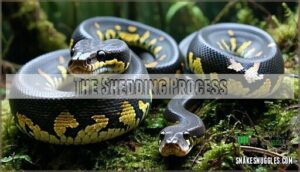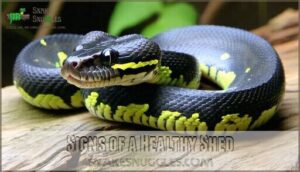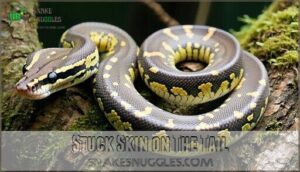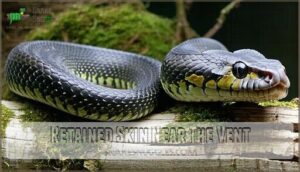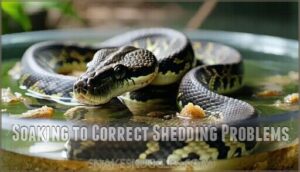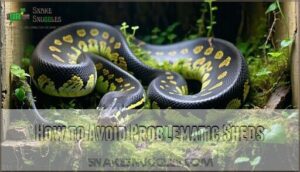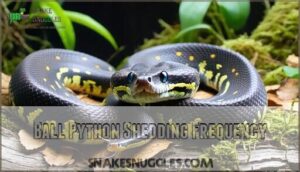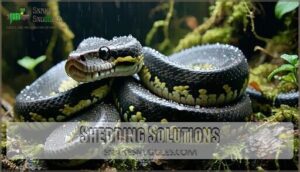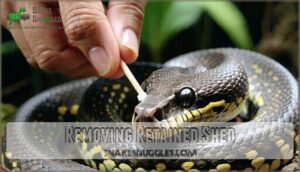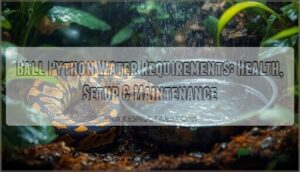This site is supported by our readers. We may earn a commission, at no cost to you, if you purchase through links.
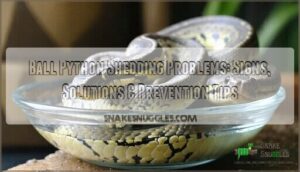
You’ll notice incomplete sheds, cloudy eye caps, or patches of dry skin, especially near the tail or vent.
Boost humidity to 60-70%, and try soaking your snake in lukewarm water for 20-30 minutes to loosen stubborn skin. A damp hide box can also work wonders.
Never pull stuck skin forcefully—it could hurt your snake. Regular hydration, proper enclosure setup, and stress reduction can prevent future issues.
Curious about tackling tricky sheds or handling eye cap retention? Stick around for expert tips.
Table Of Contents
- Key Takeaways
- The Shedding Process
- Signs of a Healthy Shed
- Common Shedding Problems
- Soaking to Correct Shedding Problems
- How to Avoid Problematic Sheds
- Ball Python Shedding Frequency
- Shedding Solutions
- Retained Shed Solutions
- Eye Cap Retention Solutions
- Advanced Shedding Issues
- Frequently Asked Questions (FAQs)
- Why do ball pythons shed?
- How do you know if a ball python has shed?
- How long does it take a ball python to shed?
- How to keep a ball python from shedding?
- Do pythons shed?
- How do you know if a ball python is healthy?
- What to do if your snake is having trouble shedding?
- Why is my ball python shedding so much?
- Should I leave my ball python alone while shedding?
- How to help ball python with bad shed?
- Conclusion
Key Takeaways
- Keep humidity levels between 60-80% to prevent stuck skin and retained eye caps during shedding.
- Soak your snake in lukewarm water for 10-20 minutes to loosen stubborn shed safely.
- Provide a damp hide with sphagnum moss for extra moisture and a secure shedding environment.
- Avoid pulling off stuck skin; instead, focus on proper hydration, enclosure setup, and stress reduction.
The Shedding Process
Your ball python’s shedding process involves the complete removal of its outer skin layer, allowing for growth and eliminating potential parasites.
The shedding process allows your ball python to grow, reveal vibrant colors, and maintain healthy skin free from parasites.
You’ll notice this natural cycle starts with dull skin and cloudy eyes, continues through the actual shedding phase, and ends with your snake displaying vibrant colors and returning to normal behavior, which is a sign of a healthy shedding process.
Pre-shed Phase Signs
Your ball python begins its shedding cycle with several telltale signs.
Watch for dull skin losing its luster and eyes turning cloudy or bluish-opaque.
You’ll notice increased hiding behavior as your snake seeks security during this vulnerable time.
Expect a decreased appetite or complete food refusal.
A pink belly tint often appears, especially visible on lighter morphs.
These pre-shed indicators typically emerge 5-7 days before actual shedding begins, signaling the start of a new shedding cycle with distinct signs, including a change in appetite, which can be a complete food refusal.
Shedding Phase Characteristics
After the pre-shed signals, your ball python enters the active shedding phase. During this time, you’ll notice increased skin rubbing against enclosure objects.
Your snake’s eyes change from clear to dull, then blue or milky, and finally opaque as fluid builds between skin layers.
- Temperature influence: Maintain 85-90°F hot spots to support the process
- Appetite loss: Most pythons refuse food during this period
- Eye changes: "Blue phase" lasts 5-7 days
- Humidity impact: Keep levels at 60-75% for smooth shedding
Post-shed Phase Indicators
While your snake undergoes shedding, changes continue until completion.
After the process finishes, you’ll notice several positive indicators, including vibrant coloration and clear eyes without any retained eye caps.
Watch for a return to normal behavior and activity levels as your snake feels comfortable again, and most pythons regain their appetite within days after a complete shedding of skin.
The skin should have good elasticity and appear problem-free with no stuck pieces, which is a sign of a complete shedding of skin, and if you notice anything unusual like incomplete sheds or dullness, this may signal an issue requiring attention.
Signs of a Healthy Shed
You’ll know your ball python has completed a healthy shed when the skin comes off in one complete piece from nose to tail tip.
A healthy shed means flawless skin removal from nose to tail, showcasing your ball python’s vibrant, rejuvenated colors and excellent health.
A healthy shed also shows clear, unclouded eyes and a return to vibrant coloration, indicating your snake is growing properly and maintaining good health.
Consistent Color Change
During shedding, your ball python’s color intensity transforms noticeably.
A healthy shed reveals vibrant post-shed coloration with enhanced pattern clarity.
Watch for these color indicators:
- Skin transformations from dull gray to bright, scale iridescence returns
- Pattern details become sharper with clear borders
- Natural genetic influence on coloration becomes more pronounced
This consistent color transformation signals good skin health—your snake’s equivalent of a rejuvenating makeover! It highlights the importance of healthy shed in maintaining your ball python’s appearance.
Clear Eyecaps
One clear indicator of a healthy shed is the complete removal of eye caps.
When examining your ball python, properly shed eye caps reveal bright, shiny eyes with no cloudy film remaining.
Retained eye caps can lead to vision impairment and potential infections if left untreated.
Maintaining proper humidity (60-80%) is essential for preventing these issues.
If you notice opaque eyes after shedding, veterinary assistance may be necessary for safe eye cap removal.
Complete Shedding of Skin
A perfect shed is your ball python’s health report card in physical form. When your snake achieves complete ecdysis (shedding in one piece), it indicates ideal conditions and excellent skin health.
Here’s what a healthy, complete shed looks like:
- The shed comes off in a single piece from nose to tail tip, maintaining shed integrity
- The skin appears inside-out, like removing a sock
- No patches of retained shed remain on your snake’s body
- Eye caps are fully detached, leaving clear, bright eyes
Proper humidity (60-80%) is vital for preventing ball python shedding problems. A healthy shed often means complete shedding occurs in one piece. If you notice stuck shed, don’t pull it off! Instead, try increasing enclosure humidity or using appropriate shedding solutions to help your reptile friend complete this natural process.
Remember, a healthy shed is crucial, and by following these guidelines, you can ensure your ball python has the best chance of achieving one, which is a sign of excellent skin health.
Common Shedding Problems
You’ll encounter several common shedding issues with your ball python, including incomplete sheds, retained eye caps, and stuck skin on the tail or near the vent.
These problems typically result from improper humidity levels or underlying health conditions that need prompt attention.
Incomplete Sheds
While a perfect shed comes off in one piece, incomplete sheds occur when skin fragments remain attached to your ball python.
Causes include low humidity (below 60%), dehydration, or stress.
The severity varies from minor flaking to significant retained shed requiring treatment.
Prevention involves maintaining proper humidity and providing rough surfaces for rubbing.
Proper humidity, between 70-90%, can help prevent boa constrictor shedding problems.
For stuck shed removal, a warm soak often helps, improving future sheds through proper husbandry.
Retained Eye Caps
Recognizing retention of eye caps (spectacles) is essential for your ball python’s health. These clear eyecaps sometimes remain after shedding, appearing as a thin film over the eye.
To safely remove retained eye caps, try a lukewarm bath, then gently dab the edge with a cotton swab. For stubborn cases, reptile eye drops can help.
Specific eyedrops may assist with shedding. If eye caps persist or layer, veterinary care is necessary.
Prevention includes proper humidity and regular enclosure misting, especially during shedding cycles.
Stuck Skin on The Tail
When your ball python’s tail doesn’t shed completely, it can lead to serious circulation problems.
Retained skin on the tail requires prompt attention to prevent infection risk and scale damage.
- Create abrasive surfaces in the enclosure for natural shedding aid
- Soak the tail in warm water (85°F) for 10-15 minutes
- Gently wipe with a damp cloth to remove skin retention issues
- Seek veterinary care if tail tip darkens or doesn’t improve, which can indicate a need for veterinary attention.
Retained Skin Near The Vent
While tail issues can cause problems, retained skin near the vent requires equally careful attention.
This sensitive area can harbor bacteria when shed skin remains, increasing infection risk.
Soak your ball python in lukewarm water (85°F) for 15-20 minutes, then gently massage the area to help loosen stuck skin.
Never pull forcefully, and maintain 60-70% humidity to prevent snake shedding problems around this delicate region, and provide a moist hide.
Soaking to Correct Shedding Problems
You can help your ball python overcome shedding problems with a gentle soak in lukewarm water (80-85°F) for 10-15 minutes.
This simple procedure softens stuck shed and provides much-needed moisture to help your snake complete its shedding process naturally, which can be aided by a gentle soak.
Benefits of Soaking
When shedding problems arise, soaking offers multiple benefits for your ball python.
A warm water soak provides immediate hydration boost, helping your snake overcome difficult sheds.
- Softens stubborn skin for easier removal
- Aids in mite removal during infestations
- Reduces stress through gentle immersion
- Provides natural shed assistance
- Increases overall hydration levels
Soaking creates the moisture your python needs, making the shedding process smoother and less stressful for your reptilian companion, and provides a natural way to aid in shed assistance, which is essential for maintaining your snake’s overall hydration.
Proper Soaking Techniques
Now that you understand soaking benefits, let’s master proper techniques. For effective snake soaking methods, use lukewarm water (85°F/29°C) in a container with sides high enough to prevent escape but low enough for your ball python to keep its head above water.
Keep soak duration between 10-15 minutes to minimize stress. Consider purchasing specialized soaking products for ideal results. Choose a container approximately twice your snake’s width with water depth of half its body height.
For stubborn shed issues, try these techniques:
- Line a plastic tub with a warm, damp towel
- Create a humidity box with moistened paper towels
- Use a shallow water dish with safe additives like reptile-safe shed aid
The goal is to create an environment that helps your snake shed comfortably, and using the right soaking methods can make a significant difference.
Precautions and Considerations
While soaking helps with shedding problems, safety comes first.
Keep water temperature lukewarm (80-85°F) to prevent thermal shock.
Never fill water above your ball python’s mid-body, and limit soaks to 15-20 minutes.
Remain present throughout to prevent drowning—a common beginner mistake.
After soaking, gently pat your snake dry with a soft towel.
For persistent shedding issues affecting long-term health, veterinary consultation is recommended over DIY shedding aids.
How to Avoid Problematic Sheds
You can prevent most shedding problems in your ball python by maintaining proper humidity levels between 55-65% and increasing to 75% during shedding cycles.
Providing a moist hide box with sphagnum moss and ensuring clean water is always available will help your snake shed its skin in one complete piece, which is crucial for a successful shedding process with complete skin removal.
Maintain Proper Humidity Levels
After a soak, your ball python needs the right environment to prevent future shedding issues. Maintaining proper humidity levels is your most powerful tool against problematic sheds.
Keep humidity between 60-65% consistently, increasing to 70-80% when your snake shows pre-shed signs. A reliable digital hygrometer placed mid-enclosure helps you monitor conditions accurately.
To achieve the right environment, consider the following:
- Choose moisture-retaining substrates like coconut husk or cypress mulch
- Reduce excess ventilation that can dry out the enclosure
- Mist the substrate (not the snake) when humidity drops below target levels
Your ball python will thank you with clean, one-piece sheds that show off its beautiful new skin.
Ensure Hydration
Proper hydration serves as the foundation for healthy ball python shedding.
Keep water dishes full and fresh daily, using containers large enough for partial soaking.
Watch for wrinkled skin or sunken eyes indicating dehydration.
Misting frequency should increase during pre-shed phases.
Beyond substrate choice, consider occasional supervised soaks in lukewarm water (80-85°F) for 10-15 minutes if shedding issues persist.
Remember, a well-hydrated snake is less likely to experience problematic sheds, which is crucial for a successful shedding process.
Provide a Damp Hiding Spot
While keeping your ball python hydrated is vital, a damp hiding spot takes humidity control to the next level.
Place a second hide box filled with damp sphagnum moss on the warm side of the enclosure. This creates a microclimate with 70-80% humidity levels for your snake to retreat to when shedding begins.
Consider using a specialized enclosure for this purpose. Choose non-molding hide materials and refresh the moss weekly to prevent bacterial growth.
Maintain Good Enclosure Hygiene
Your ball python’s enclosure hygiene directly impacts successful shedding. Choose substrates like cypress mulch or coconut husk that balance moisture retention with waste absorption.
Remove droppings and soiled bedding daily, and do a complete substrate change every 4-6 weeks. Disinfect all surfaces monthly with reptile-safe cleaners.
Keep water dishes clean and fresh. Consistent enclosure maintenance prevents bacterial growth that can lead to shedding problems in your ball python.
Minimize Stress
After keeping the enclosure clean, your attention should shift to reducing stress during shedding periods. Minimizing stress plays a major role in preventing shedding problems in ball pythons.
During this vulnerable time, your snake needs extra consideration. Reduce handling frequency to only when necessary, as excessive contact can cause significant distress.
- Provide multiple secure hides that won’t tip over easily
- Install visual barriers along one or two sides of the enclosure
- Keep the room quiet, avoiding sudden loud noises
Maintaining consistent temperatures and a regular feeding schedule further reduces anxiety. Remember, a relaxed ball python will shed more completely and recover faster afterward.
Ball Python Shedding Frequency
Your ball python’s shedding schedule changes throughout its life, with younger snakes shedding every 4-6 weeks while adults typically shed just once every 10-14 weeks.
Understanding your snake’s normal shedding pattern helps you quickly identify potential health issues when that pattern changes, which is crucial for maintaining your snake’s overall health and well-being.
Hatchling Shedding
After setting up proper humidity levels, you’ll need to prepare for your hatchling’s unique shedding patterns.
Hatchlings shed their first skin approximately two weeks after hatching, then much more frequently than adults due to their rapid growth rate. Early sheds indicate healthy development in your ball python.
Shedding frequency depends on overall skin health.
| Hatchling Stage | Shedding Frequency | Recommended Humidity |
|---|---|---|
| First Hatch | 2 weeks after birth | 70-80% |
| 0-3 months | Every 3-4 weeks | 65-75% |
| 3-6 months | Every 4-6 weeks | 60-70% |
Watch for feeding impact on shedding timing, as it is crucial for understanding your ball python’s shedding patterns and ensuring their overall health.
Adult Shedding
Unlike young snakes, adult ball pythons typically shed every 10-14 weeks. As your snake matures, you’ll notice these changes in their shedding patterns.
- Adult frequency decreases to 3-4 times yearly
- Diet impact can alter timing between sheds
- Seasonal sheds occur less frequently in winter
- Husbandry effects directly influence shed quality
- Health indicators may appear through shedding patterns
Watch for ball python shedding problems like skin retention, which might require a gentle shedding aid for proper removal. It’s essential to monitor husbandry effects and diet impact on shedding to ensure the snake’s health and well-being, and to recognize potential health indicators.
Factors Affecting Shedding Frequency
While adult ball pythons shed less often, several factors affect shedding frequency.
| Factor | Impact on Shedding |
|---|---|
| Age and Shedding | Younger snakes shed every 4-6 weeks; adults every 10-14 weeks |
| Diet Influence | Proper nutrition supports healthy cycles |
| Hydration Levels | Well-hydrated snakes shed more completely |
| Environmental Conditions | Higher humidity (70-80%) promotes better shedding |
| Health Status | Illness can disrupt normal patterns |
You’ll notice changes in shedding frequency with seasonal temperature shifts and humidity changes, which can be influenced by the environmental conditions and the snake’s health status.
Shedding Solutions
Now that you understand how often your ball python sheds, let’s focus on practical solutions for a smooth shedding process.
When your snake starts showing shedding signs, try these five proven methods to help:
- Increase humidity to 60-80% by misting the enclosure daily.
- Create a moist hide using damp sphagnum moss for your python to retreat to.
- Apply commercial shedding aids following package instructions.
- Offer a shallow warm water bath (85°F) for 15-20 minutes to soften stubborn skin.
- Provide rough surfaces like cork bark for natural friction.
You’ll know these methods work when your snake sheds in one complete piece. Maintaining proper humidity and temperature is also critical for healthy shedding. For persistent issues, don’t hesitate to seek a veterinary consult. Remember, gentle assistance is key—never pull stuck shed forcefully as this can harm your snake’s delicate skin. Check out humidity and temperature for more information.
Retained Shed Solutions
You’ll need to address retained shed quickly to prevent health complications in your ball python.
When you notice stuck skin, increase humidity to 75% and provide a 15-minute warm water soak to help loosen the stubborn patches.
Causes of Retained Shed
When your ball python has trouble shedding completely, specific environmental factors are usually to blame.
After trying various shedding solutions, it’s important to address the root causes:
- Low humidity levels (below 50%) make skin rigid and difficult to remove
- Dehydration issues prevent proper skin separation during the shedding process
- Lack of abrasive surfaces in the enclosure limits the snake’s ability to rub against objects
- Improper temperature gradients slow metabolic processes needed for healthy shedding
Stress factors like frequent handling or inadequate hiding spots can also disrupt natural shedding patterns.
Addressing these environmental conditions is key to preventing future retained shed problems.
Removing Retained Shed
When facing retained shed, try a supervised soak in lukewarm water (80-85°F) for 20-30 minutes to soften the stubborn shed.
After soaking, use a damp towel or wet cotton bud/qtip to gently work around problem areas.
For stuck eyecaps, use a moistened cotton swab with gentle circular motions.
Watch for signs of scale rot, and seek veterinary assistance if retained shed persists.
Preventing Retained Shed
While removing retained shed addresses immediate issues, prevention creates a long-term solution.
Maintain humidity between 60-70% to facilitate proper shedding cycles.
- Create a designated humid hide with damp sphagnum moss for hydration
- Clean the enclosure regularly to prevent bacterial growth
- Minimize handling during pre-shed periods to reduce stress
- Offer proper nutrition, as diet impacts skin health
Regular monitoring allows you to spot early warning signs.
Remember, proper enclosure hygiene is as important as humidity control for preventing retained shed problems.
Eye Cap Retention Solutions
You’ll need effective solutions when your ball python can’t shed the transparent scales covering its eyes.
These stuck eye caps can lead to vision problems and infections if not properly addressed with the right humidity adjustments and gentle removal techniques, utilizing effective solutions to ensure the health of your pet.
Causes of Eye Cap Retention
Eye caps may stubbornly remain during shedding due to several key factors:
- Low Humidity: Insufficient moisture in the environment prevents proper loosening of eye caps.
- Dehydration Factors: Limited water intake compromises your snake’s overall skin health.
- Physical Injury: Damage around the eye area can disrupt normal shedding.
- Nutritional Deficiencies: Poor diet may impact skin quality and shedding process.
Addressing these issues promptly helps prevent infection risks and protects your ball python’s eye health.
Removing Retained Eye Caps
When handling retained eye caps, gentle removal techniques are essential.
For safe treatment:
- Bathe your snake in lukewarm water for 15-20 minutes
- Use a damp cotton swab to carefully work around the edge of the cap
- Never force removal – this can damage delicate eye tissue
- Seek vet intervention if caps don’t come away easily
Multiple retained layers require professional assessment. Most caps will naturally release during the next shedding cycle with proper humidity.
Preventing Eye Cap Retention
Now that you know how to address existing eye cap issues, let’s focus on prevention.
To prevent retained eye caps in your ball python:
- Maintain 60-75% humidity – Proper moisture levels keep skin flexible during shedding
- Provide constant fresh water – Well-hydrated snakes shed more completely
- Create rough surfaces – Adding sanitized branches or stone gives your snake something to rub against
Regular veterinary checkups can also catch early signs of eye health problems before they worsen.
Advanced Shedding Issues
Advanced shedding issues, like shedding in pieces or failing to shed, often point to problems with humidity or overall care.
Understanding these challenges helps you address them effectively and keep your ball python healthy.
Shedding in Pieces
Shedding in pieces often points to humidity’s role in snake shedding problems.
Low humidity, dehydration, or shedding complications like incomplete sheds are common causes.
Boost enclosure humidity to 60-70% and make certain fresh water is always available.
If stuck shed persists, consider veterinary care.
Prevention includes proper husbandry and providing a damp hide to minimize shedding complications and avoid stuck shed issues.
Failure to Shed
Struggling with snake shedding, especially when your ball python fails to shed, can be frustrating.
Common culprits include improper humidity, nutritional deficiencies, or environmental factors like dehydration. Stress or underlying illnesses may also play a role.
Low humidity often leads to a stuck shed, so make certain levels stay between 70-80%.
Poor diet and genetic predisposition might contribute to scale abnormalities, complicating shedding. Watch for signs like retained skin or retained eye caps.
If adjustments don’t help, consult a vet for retained eye caps treatment or other issues. Regular care prevents most ball python shedding problems.
Over-Shedding
Over-shedding, though less common, can signal underlying issues.
Causes often include stress, infections, improper diet, or shedding frequency variations. It’s vital to address shedding triggers and inhibitors promptly.
Here’s how to tackle overshedding:
- Evaluate diet: Provide balanced nutrition.
- Reduce stress: Minimize handling and optimize the environment.
- Check for infections: Seek veterinary care if needed.
- Maintain humidity: Keep levels between 60-80% for healthy shedding.
Prevention guarantees smoother cycles.
Frequently Asked Questions (FAQs)
Why do ball pythons shed?
Ball pythons shed to grow and maintain healthy skin.
It’s like upgrading their outfit—they outgrow the old layer, remove it, and reveal fresh, vibrant skin underneath.
Shedding also helps eliminate parasites and heal minor injuries.
How do you know if a ball python has shed?
Think of it like peeling off an old sweater—your ball python’s skin will come off in one piece if conditions are right.
Look for vibrant new scales, clear eyes, and a return to normal behavior.
How long does it take a ball python to shed?
It typically takes a ball python 7 to 14 days to complete shedding.
You’ll notice signs like dull skin, cloudy eyes, and hiding behavior during this process, which ends with vibrant, fresh skin.
How to keep a ball python from shedding?
Stopping a ball python from shedding is like stopping the seasons—you can’t.
Shedding is essential for their growth and health.
Focus on maintaining proper humidity, hydration, and care to guarantee a smooth process instead.
Do pythons shed?
Yes, pythons shed their skin as they grow.
It’s a natural process called ecdysis.
Shedding helps them grow and get rid of parasites.
You’ll notice dull skin, cloudy eyes, and behavioral changes during shedding.
How do you know if a ball python is healthy?
A healthy ball python has clear eyes, smooth, vibrant skin, a consistent appetite, and steady activity levels.
It feels firm but not bony when handled, and it shows no signs of wheezing, swelling, or retained shed.
What to do if your snake is having trouble shedding?
If your snake struggles with shedding, boost humidity to 75%, provide a moist hide with sphagnum moss, and offer a lukewarm soak (85°F) for 10-15 minutes.
Avoid peeling stuck skin; consult a vet if persistent.
Why is my ball python shedding so much?
Your ball python might be shedding frequently due to rapid growth, high humidity, stress, or health issues like parasites.
Check its environment, diet, and behavior to confirm proper care and consult a vet if needed, focusing on rapid growth.
Should I leave my ball python alone while shedding?
Funny how nature works, isn’t it?
During shedding, give your ball python space.
It’s stressed, vulnerable, and likely defensive.
Avoid handling to prevent injuries and let it navigate the process naturally in peace.
How to help ball python with bad shed?
Boost humidity to 75-80% and provide a moist hide with damp moss.
Gently soak your python in lukewarm water (85°F) for 10-15 minutes.
Use a damp towel to carefully assist with removing stuck shed, focusing on the complete process to ensure your python’s comfort and safety.
Conclusion
Funny how something as natural as shedding can turn into a challenge, isn’t it?
Ball python shedding problems often boil down to humidity, hydration, and stress.
By maintaining proper enclosure conditions, providing a damp hide, and soaking when needed, you can help your snake shed smoothly.
Keep an eye out for incomplete sheds or retained eye caps, and address issues promptly.
With the right care, your ball python will stay healthy and shed like a pro.

